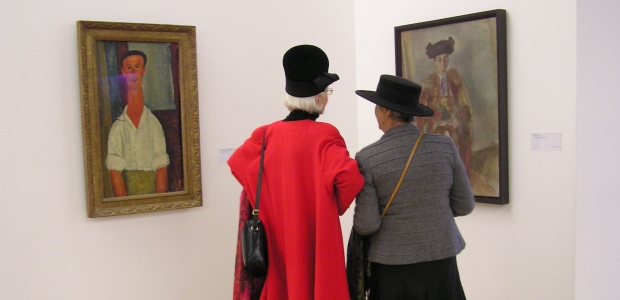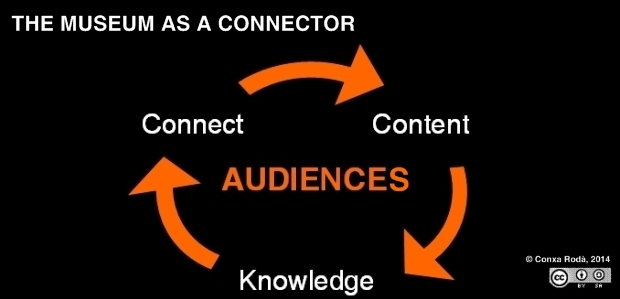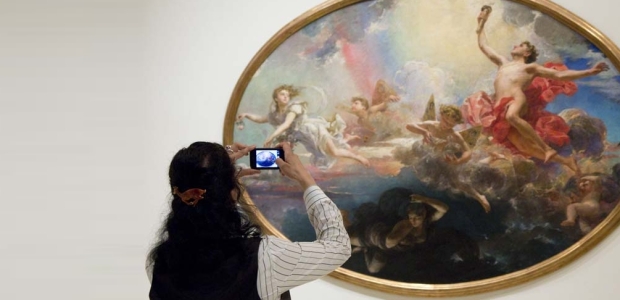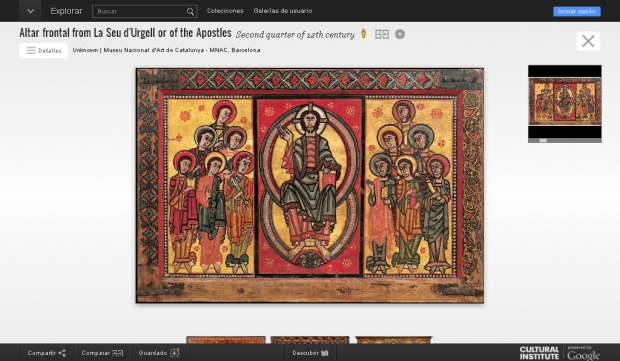Conxa Rodà

Will Digital reach all audiences? Centre Georges Pompidou. Photo: Conxa Rodà.
Connecting collections with audiences is key to the social profitability of the museums nowadays. The museums that know better how to establish multiple connections with multiple audiences will be those that have greater social impact. If we had to sum up in one word the concept of the museum, I think a very suitable word would be CONNECTOR.

Precisely “Museum collections make connections” is the topic proposed by ICOM (International Council of Museums) for the International Museum Day 2014.
The museum is evolving towards becoming a meeting place, a centre of creation, of experiences, of participation, that is to say, of connection – between the collections and the visitors, and between the visitors themselves. The museum should know how to connect collections, knowledge and audiences in such a way that they generate quality experiences.
So, why are we interested in connecting the collections with the audience? Well, as well as fulfilling the mission of the museum, this makes the collections more accessible, improves the experience of the visit, attracts new audiences, providing visibility to the scientific work and creating community, among other good reasons. Some questions we can ask: Do we provide the visitors with the context and the keys of interpretation with interactive museography? Or do we simply continue exhibiting works next to each other? Do we have our collections digitised, well documented and filled with metadata? Do we connect the online experience well with the physical visit to the museum? Or do they continue to be two parallel worlds? On how we act depends to a great extent if a connection is produced between our content and the audiences, or, on the contrary, a disconnection: “I’m not interested”, I don’t understand it”, “It’s not the right place for me”.
Websites, online collections, digital archives, social media, interactive museography, apps for mobiles, gamification, 3D printing and many other ways and digital supports today form part of the tasks of management and diffusion in museums.
Is technology disruptive or an ally?
In art museums, particularly, the question which concerns is whether the technology distracts the contemplation of the works. As I understand it, the question to pose is not if we introduce the technology in the museum, but how to use digital methods to deepen the engagement with art and the creative processes. It’s not a question of competing but to complement, to enrich. If applied to the right extent it is an excellent resource so as to offer context, comparisons and references. We are immersed in an extremely visual culture, and this is a magnificent opportunity for art museums.
However, there’s still a lot to do. According to figures from a recent study about websites of contemporary art museums in Spain, 19.3% still don’t have a website, only 29.3% allow content to be shared with other users and only 12% incorporate educational content.
Social media, blogs and mobiles: establishing connections
We don’t know how the social networks are going to evolve, but for the time being it is important to be active wherever the users are, that is to say, to go to the encounters of visitors in the networks. As my good friend Samuel Bausson of the Muséum de Toulouse says: we’ve got to get away from the “logic of the display case” to go towards a “relational logic”.
But are we getting the most out of the social platforms? Are we using the networks as platforms of conversation and interaction with the users of the museum? Or are we still acting too much as broadcasters and advertisers of what we are doing?
The blog helps to construct connections with the community, with other museums and between the staff themselves. For me the blog is an essential tool in the communication strategy of the museum because it allows a more personal approach in the day to day running and life of the museum, showing the behind-the-scenes of the work processes, offering a plural voice. However, the percentage of museums with blogs in our country is still very limited.
The mobile is ubiquitous and constant. It’s always within our reach. Are we making our content “friendly”, relevant and contextual for the small screen? A significant fact: Spain is one of the European countries with greater penetration of smartphones. The average number of apps installed per user is 19 (of which 8 are of payment). However, Spanish museums with apps: 1.8%! There’s an enormous amount still to be explored and exploited.

A visitor taking pictures of a work of Antoni Caba.
However, prior to producing apps, the priority is surely to adapt the websites of the museums to mobiles (responsive design, RWD), not only by formatting the screen but also resizing images to optimize the speed of loading and rethinking the browsing architecture.
An excellent example of how to connect the collections to the public via mobile can be seen with the app Exchanging Gazes of the Museo Thyssen. Each look uncovers a world of secrets and relations between works: What does a work of Durero have in common with one of Kokoschka, one of Hopper with that of Amorosi, or a work of Lucian Freud with one of Watteau?
Closer collections
A powerful connection instrument can be found in the online collections. It’s not necessary to have a perfectly documented collection to publish it. This can take years, and meanwhile our collections will be inaccessible. I would like to highlight the pioneering work of the V&A, who decided to publish the whole of their collection, specifying the registers that still had to be completed or revised, and even inviting the users to collaborate by touching up the images or improving the search engine of the collection. Another example, very spectacular, is the Collection Wall of the Cleveland Art Museum and, recently, the most celebrated example in Europe has been the Rijksmuseum of Amsterdam, that has not only made available thousands of works of extremely high resolution but they have also opened what they call the Rijksstudio in which they invite the users to “get close” to the works and to make their own creation based on them.
Collaborative platforms: global connection
It is clear that we cannot just wait for the users to come to our museum or visit our websites, we need to go out and diversify our presence in as many platforms and networks as possible if we really want to connect with the audiences. Three powerful external platforms for connecting the collections are: Google Art Project, an online platform with 30,000 works of art from museums from all over the world, in high resolution and with many functionalities; Europeana, repository of European heritage that already includes more than 30 million objects from among museums and libraries, and also to establish connections it is essential to have a good presence in Wikipedia, the most consulted encyclopaedia in the world, and therefore it is very interesting for us that our content and our collections are in Wikipedia and with the maximum quality.

Museu Nacional d’Art de Catalunya. Google Art Project. Altar frontal from La Seu d’Urgell, 12th century.
In the Museu Nacional d’Art de Catalunya we are present and active in the three. This, we believe, is a digital strategy to boost.
What needs to be done to connect the audiences with content?
Strategy, mediation, a good programme of events, both scientific and of diffusion, networking, visitor studies, transversal internal organisation of collaborative work, and above all, an open mentality: open to change, open to catching the interests of the audiences, open to exploring new ways of connection with this audience. Without any doubt – these are exciting times.
Do you know of any digital initiatives ‘connectors’ of museums that you would like to share?
Related links:
Museum Connector (ppt, in Spanish)
Interview: “Digital dimension in museums” (in Spanish)
Co-directora del Curs d'Estratègia Digital_UOC_Museu Nacional d'Art de Catalunya
Co-directora del congrés CIMED de Museos y Estrategias Digitales








One comment
Gracias por la información! Me es de gran interés y me gustaría compartirla con mis colegas de la https://www.uautonoma.cl/ .
Saludos!